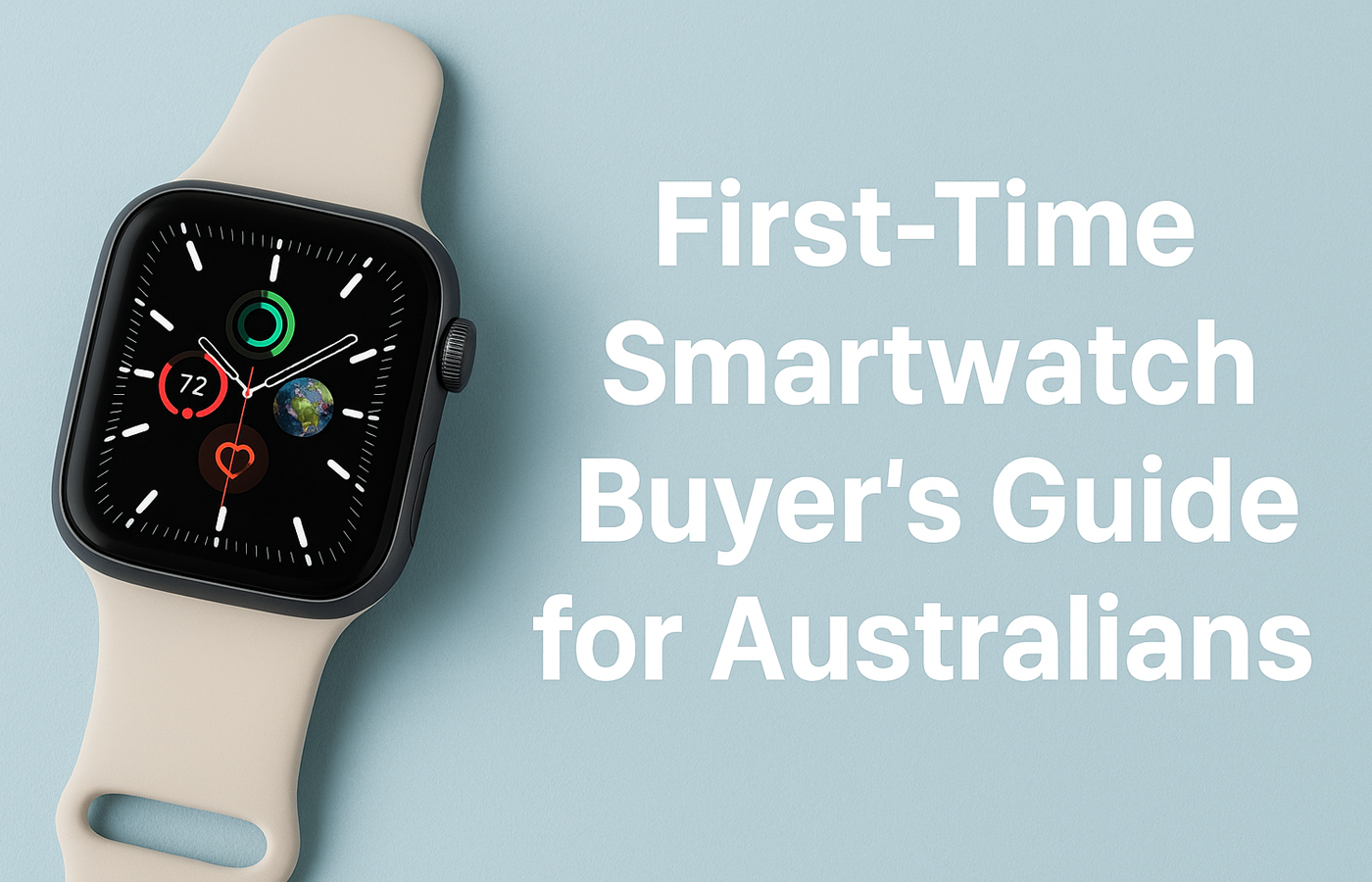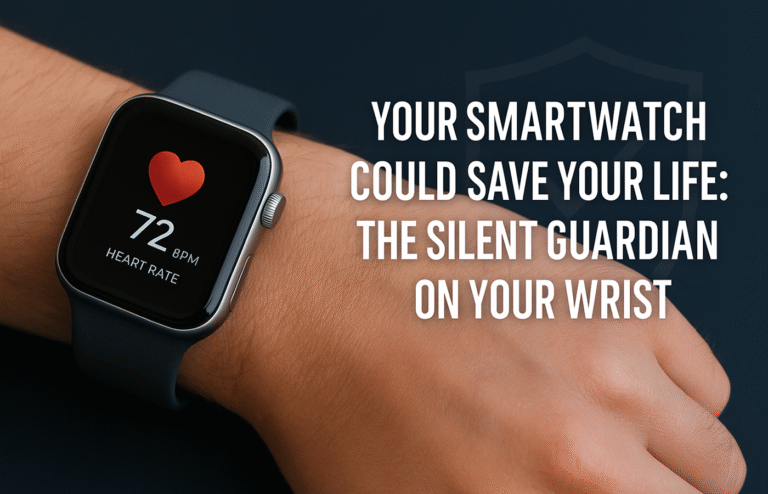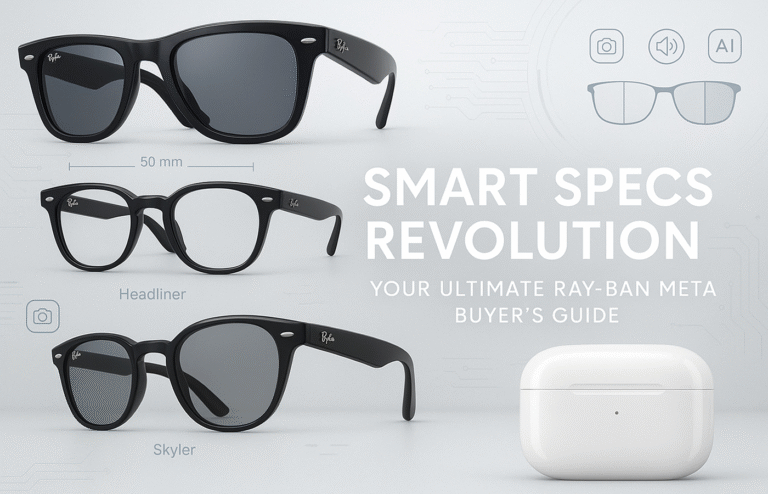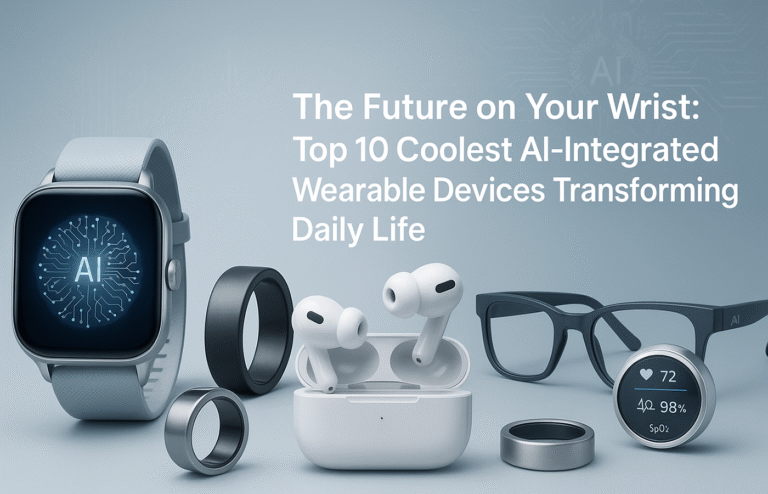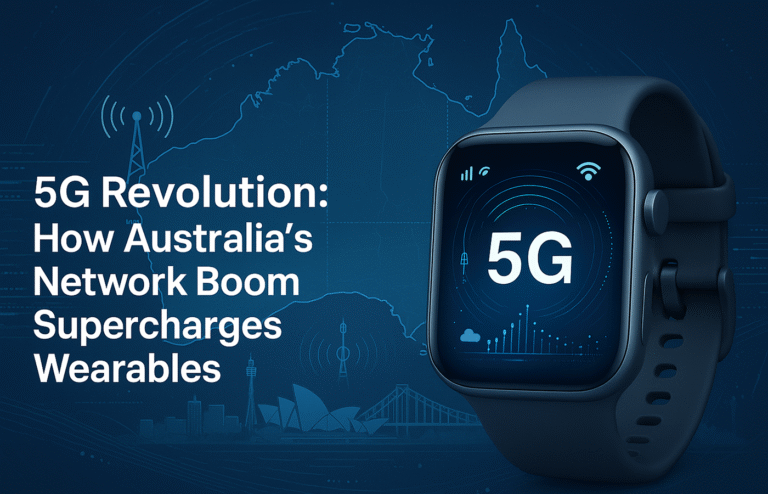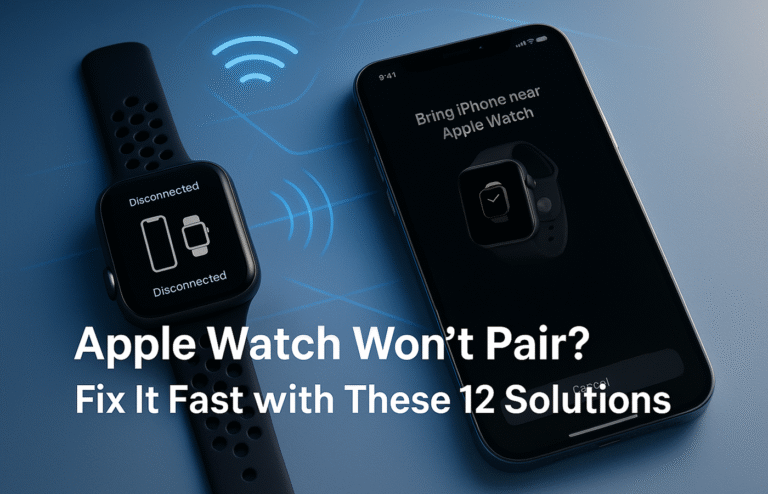First-Time Smartwatch Buyer’s Guide: Essential Advice for Australian Newcomers
Modern smartwatches simplify daily life through health tracking, communication management, convenience features, and lifestyle integration whilst being genuinely user-friendly for beginners.
Top Beginner Recommendations:
● Apple Watch Series 9 ($399-799): Best iPhone integration with seamless Australian payment systems
● Samsung Galaxy Watch Ultra ($299-699): Excellent Android compatibility with 2-3 day battery life
● Garmin Vivosmart 5: Fitness-focused simplicity with 7-day battery life for health enthusiasts
● Google Pixel Watch 2: Clean interface with superior Google services integration
Essential Considerations:
● Australian carrier compatibility for cellular models (Telstra, Optus, Vodafone support)
● Water resistance (minimum 5ATM) for climate protection and daily use
● Total ownership costs including monthly plans ($5-15), bands ($30-100), and accessories
Beginner Tips: Start with conservative notification settings, focus on basic step counting initially, and try devices in-store before purchasing.
First-Time Smartwatch Buyer’s Guide for Australians
Category: Beginner’s Guide
So you’re thinking about joining the smartwatch revolution? Maybe you’ve seen colleagues checking messages on their wrist during meetings, or perhaps your GP mentioned that tracking your daily activity could help with that health goal you’ve been putting off. Whatever brought you here, you’re probably wondering: “Do I actually need a smartwatch, and if so, which one won’t leave me feeling like I need a computer science degree to use it?”
The good news is that modern smartwatches have evolved far beyond the complicated gadgets of a few years ago. Today’s devices are genuinely useful tools that can simplify your daily life, improve your health awareness, and keep you connected without constantly reaching for your phone. The trick is finding the right one for your specific needs and lifestyle.
Let’s cut through the marketing hype and technical jargon to help you make a smart choice for your first smartwatch purchase.
What Exactly Can a Smartwatch Do for You?
Before diving into specific models, it’s worth understanding what you’re actually getting for your money. Modern smartwatches are essentially miniature computers that focus on four main areas:
Health and Fitness Tracking Your smartwatch becomes your personal health assistant, monitoring heart rate, tracking steps, analysing sleep patterns, and even detecting irregular heart rhythms. For many Australians, this health monitoring becomes the most valuable feature, especially as we become more conscious of preventive healthcare.
Communication and Notifications Receive texts, calls, and app notifications directly on your wrist. This means you can stay connected during meetings, workouts, or when your phone is buried in a bag. You can even respond to messages using voice dictation or quick replies.
Convenience Features Pay for your morning coffee with a flick of your wrist, use your watch as a flashlight during Brisbane’s summer storm blackouts, or get turn-by-turn directions without pulling out your phone while navigating Melbourne’s confusing hook turns.
Lifestyle Integration Control your smart home devices, track your location during hikes in the Blue Mountains, set multiple alarms for shift work, or use your watch as a remote camera trigger for those perfect family photos.
Understanding the Australian Smartwatch Market
Carrier Compatibility If you want a smartwatch with its own mobile connection (so it works without your phone nearby), you’ll need to ensure it’s compatible with Australian networks. Telstra, Optus, and Vodafone all support smartwatch plans, but not every international smartwatch model works with our networks.
Warranty and Support Considerations Buying from Australian retailers ensures you’re covered by Australian Consumer Law protections. Grey imports might be cheaper, but you’ll miss out on local warranty support and may face compatibility issues with Australian payment systems and cellular networks.
Climate Considerations Australia’s diverse climate means your smartwatch needs to handle everything from Melbourne’s four-seasons-in-one-day weather to Darwin’s tropical humidity and Perth’s dry heat. Look for water resistance ratings and temperature tolerance specifications.
The Top Contenders for First-Time Buyers
Apple Watch Series 9 (Best Overall for iPhone Users)
Why It’s Great for Beginners: Apple’s ecosystem integration makes this the most user-friendly option if you already own an iPhone. Setup takes minutes, and the interface feels familiar to anyone who’s used an iPhone or iPad.
Key Features:
- Excellent health tracking including ECG and blood oxygen monitoring
- Seamless integration with Australian payment systems (Apple Pay works everywhere contactless payments are accepted)
- Strong app ecosystem with Australian-specific apps like CommBank, Woolworths Everyday Rewards, and PTV Mobile
- Reliable emergency features including fall detection and Emergency SOS
Considerations:
- Only works with iPhones
- Battery typically lasts 1-2 days depending on usage
- Premium pricing ($399-$799 depending on model and features)
Samsung Galaxy Watch Ultra (Best for Android Users)
Why It’s Great for Beginners: Samsung has simplified their interface significantly, and the rotating bezel makes navigation intuitive even for those not comfortable with touchscreens.
Key Features:
- Works with most Android phones, not just Samsung devices
- Excellent fitness tracking with detailed sleep analysis
- Strong battery life (2-3 days typical usage)
- Built-in GPS for accurate outdoor activity tracking
- Samsung Pay compatibility with Australian banks
Considerations:
- Some features work better with Samsung phones than other Android devices
- Interface can feel overwhelming initially compared to Apple Watch
- Pricing ranges from $299-$699
Garmin Vivosmart 5 (Best for Fitness-Focused Beginners)
Why It’s Great for Beginners: If your primary interest is fitness and health tracking without the complexity of a full smartwatch, Garmin offers the best balance of features and simplicity.
Key Features:
- Exceptional battery life (up to 7 days)
- Comprehensive fitness tracking including VO2 max and stress monitoring
- Water-resistant for swimming
- Simple interface focused on health metrics
- Works with both iPhone and Android
Considerations:
- Limited smart features compared to Apple or Samsung
- No colour display on entry models
- Fewer third-party apps available
Google Pixel Watch 2 (Best Google Integration)
Why It’s Great for Beginners: Perfect for those already using Google services like Gmail, Google Pay, and Google Assistant. The interface is clean and intuitive.
Key Features:
- Excellent Google Assistant integration
- Seamless Gmail and Google Calendar notifications
- Google Pay support for Australian contactless payments
- Comprehensive health tracking through Fitbit integration
- Clean, minimalist design
Considerations:
- Newer to the market with smaller app ecosystem
- Battery life is adequate but not exceptional (1-2 days)
- Works best with Google Pixel phones
Essential Features to Consider
Health and Fitness Tracking
Heart Rate Monitoring All modern smartwatches include heart rate sensors, but accuracy varies. If you have specific health concerns, look for devices with medical-grade sensors and FDA/TGA approvals for health monitoring.
Sleep Tracking Quality sleep tracking requires wearing your watch overnight, so comfort and battery life become crucial factors. Some watches provide detailed sleep stage analysis, while others offer basic duration tracking.
Activity Recognition The best smartwatches automatically detect when you’re walking, running, swimming, or cycling without needing to manually start a workout. This passive tracking provides a more complete picture of your daily activity.
Connectivity Options
GPS Built-In Essential for accurate outdoor activity tracking and navigation. Built-in GPS means your watch doesn’t rely on your phone’s location services, providing better accuracy and battery efficiency.
Cellular Connectivity This allows your watch to work independently of your phone for calls, texts, and data. It’s particularly useful for runners who don’t want to carry their phone, but adds to monthly costs through carrier plans.
Wi-Fi and Bluetooth Standard features that allow your watch to connect to home networks and sync with your phone. Ensure the watch supports the latest Bluetooth standards for better battery efficiency.
Battery Life and Charging
Daily Usage Expectations Most smartwatches require daily charging, similar to smartphones. However, battery life varies significantly based on features used. GPS tracking, cellular connectivity, and always-on displays drain battery faster.
Charging Methods Look for magnetic charging cables or wireless charging compatibility. Some watches charge quickly (30 minutes for a day’s use), while others require several hours for a full charge.
Battery Degradation Like all lithium batteries, smartwatch batteries degrade over time. Consider the availability and cost of battery replacement services when making your choice.
Setting Up Your First Smartwatch
Initial Configuration
Phone Pairing Your smartwatch setup begins with downloading the manufacturer’s app on your phone. This process typically takes 15-30 minutes and includes setting up health profiles, notification preferences, and payment methods.
Privacy Settings Take time to understand what health data is collected and how it’s used. Most manufacturers allow you to control data sharing with third parties, including health insurance companies.
Customisation Options Modern smartwatches offer extensive customisation through watch faces, complications (small widgets showing information), and app arrangements. Start simple and add complexity as you become comfortable.
Essential Apps for Australians
Payment Apps Set up Apple Pay, Google Pay, or Samsung Pay for contactless payments. Most Australian banks support smartwatch payments, making it incredibly convenient for daily purchases.
Transport Apps If you live in major cities, download apps like Opal Travel (Sydney), myki (Melbourne), or go card (Brisbane) for easy public transport access.
Health Apps Connect your smartwatch to Medicare’s My Health Record system if desired, and consider apps like MyFitnessPal for nutrition tracking or Headspace for meditation.
Weather and Emergency Apps Australian weather can change quickly. Apps like Bureau of Meteorology’s WeatherZone or Emergency Plus provide crucial information accessible from your wrist.
Practical Usage Tips for Beginners
Daily Routine Integration
Morning Setup Most people find success by incorporating their smartwatch into existing routines. Put it on while having your morning coffee, check overnight health metrics, and review the day’s weather and calendar.
Notification Management Start with conservative notification settings—only allow calls, texts, and a few essential apps to send alerts. You can always add more later, but notification overload is a common reason people abandon their smartwatches.
Evening Routine If you plan to use sleep tracking, establish a charging routine that works with your schedule. Many users charge their watch while showering and getting ready in the morning.
Fitness Integration
Start Simple Begin with basic step counting and try to hit the common 10,000 steps per day goal. As you become comfortable, explore more advanced features like heart rate zones and workout tracking.
Set Realistic Goals Smartwatches excel at encouraging incremental improvements. Set achievable goals that gradually increase over time rather than immediately aiming for marathon-level fitness.
Use Social Features Many smartwatch platforms include friend challenges and sharing features that can provide motivation and accountability for fitness goals.
Common First-Time Buyer Mistakes to Avoid
Over-Specification
Feature Overload Don’t get caught up in having every possible feature. A smartwatch with excellent basic functionality often provides better daily value than one packed with complex features you’ll never use.
Size Considerations Smartwatches come in multiple sizes. Generally, smaller wrists look better with smaller cases (38-42mm), while larger wrists can accommodate bigger displays (44-49mm). Try before you buy when possible.
Under-Specification
Skimping on Water Resistance Even if you don’t plan to swim with your watch, water resistance protects against rain, hand washing, and accidental splashes. Look for at least 5ATM water resistance.
Ignoring Band Quality You’ll wear your smartwatch for many hours daily, so band comfort matters enormously. Cheaper bands can cause skin irritation or break quickly. Consider the long-term cost of replacement bands.
Platform Lock-In
Ecosystem Considerations Remember that smartwatches work best within their manufacturer’s ecosystem. If you might switch from iPhone to Android (or vice versa) in the future, consider how this affects your smartwatch choice.
Budget Considerations and Value
Total Cost of Ownership
Initial Purchase Price Entry-level smartwatches start around $200, while premium models can exceed $800. However, the initial price is just part of the total cost.
Ongoing Costs Factor in monthly cellular plan costs ($5-15 per month), replacement bands ($30-100), screen protectors ($10-30), and potential battery replacement costs after 2-3 years.
Insurance and Protection Consider whether your home and contents insurance covers smartwatch damage or theft. Some people find dedicated device insurance worthwhile for expensive models.
When to Buy
Sales Cycles Smartwatch prices typically drop when new models are announced. Apple releases new watches in September, Samsung usually announces in summer, and other manufacturers follow various schedules.
End-of-Financial-Year Sales Australian retailers often offer significant discounts during June-July sales, making it an excellent time for first-time buyers to enter the market.
Making Your Decision
Assess Your Primary Needs
Ask yourself these key questions:
- Is fitness tracking or staying connected more important to you?
- Do you prefer simplicity or customisation options?
- What’s your realistic budget including ongoing costs?
- How important is having the latest technology versus proven reliability?
Try Before You Buy
Retail Showrooms Visit JB Hi-Fi, Harvey Norman, or Apple/Samsung stores to physically try different models. Pay attention to comfort, display visibility, and interface responsiveness.
Return Policies Understand return policies before purchasing. Most Australian retailers offer 14-30 day return periods, which is often enough time to determine if a smartwatch suits your lifestyle.
Start Your Smartwatch Journey
Your first smartwatch should enhance your daily life without creating stress or complexity. Focus on models from established manufacturers with strong Australian support, choose features that align with your actual needs rather than aspirational goals, and remember that you can always upgrade to more advanced models as your comfort and requirements evolve.
The smartwatch market continues to mature, with devices becoming more reliable, user-friendly, and genuinely useful for everyday Australians. Whether you’re looking to improve your health awareness, streamline daily tasks, or simply join the wearable technology revolution, there’s likely a smartwatch that fits your lifestyle and budget.
Take your time with the decision, start with essential features, and prepare to discover how a well-chosen smartwatch can quietly improve dozens of small interactions throughout your day. Welcome to the future of wearable technology—it’s more accessible and practical than you might think.

